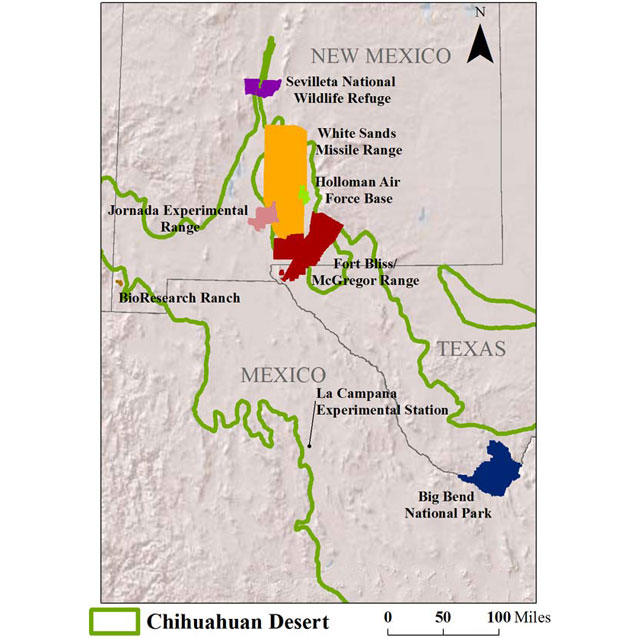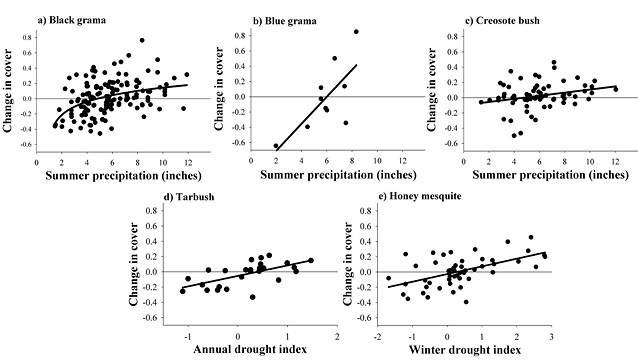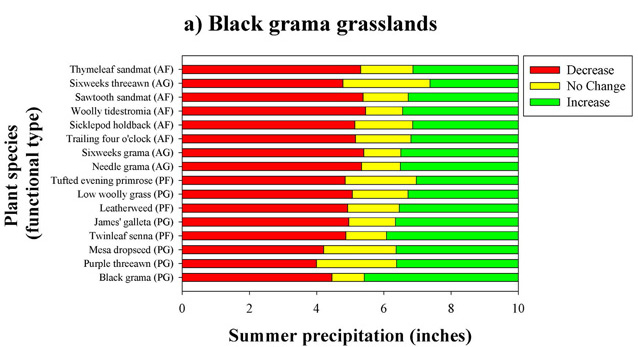Determining the impact of climate on vegetation is especially important in desert regions that are prone to land degradation. Vegetation changes can dramatically change the productive capacity and diversity of a site, alter food and habitat for wildlife, and affect soil erosion, carbon and nutrient cycling.
Future warming and changes in the timing and amount of precipitation predicted by global change models can have a strong impact on plant species already stressed by low water availability in national parks of the southwestern U.S. An understanding of climate-vegetation relationships is important to both short-term management decisions, and to long-term planning for the effects of projected climate change in national parks. Determining the impact of climate on vegetation is especially important in desert regions that are prone to land degradation, which may include: (1) transitions from grass to shrub dominance, (2) risks of losing total perennial vegetation cover, and (3) susceptibilities to invasion by non-native species. These vegetation changes can dramatically change the productive capacity and diversity of a site, alter food and habitat for wildlife, and affect soil erosion, carbon and nutrient cycling.
Methods

In order to identify regional trends in plant species responses to climate across the Chihuahuan Desert and forecast how projected climate changes could affect future plant species assemblages, we paired results from climate and vegetation vital signs monitoring across eight study sites in the Chihuahuan Desert (Figure 1) over the last century (1915-2010). Monitoring plots at sites ranged in elevation from 3,900 to 6,200 ft., and represent grasslands associated with landscape position: (1) lowland tobosa grasslands found in depression areas that periodically flood, (2) upland black grama grasslands that occur on rolling plains and alluvial fans (bajadas), and (3) foothill blue grama grasslands that occur on the lower positions of mountain slopes. All shrublands in this study were found on rolling plains and bajadas (uplands): (4) creosote bush, (5) honey mesquite, and (6) tarbush shrublands. The dominant shrub present depended on soil texture and the degree of slope.
Our specific goals for this study were to determine the responses of dominant plant species and species richness (number of plant species=an index of diversity) in these grasslands and shrublands to increased warming and drought, and to identify critical points along a range of climatic conditions that indicate shifts in plant performance. In order to determine plant species responses and climate “pivot points,” we assessed how much plant cover of a species changed from one measurement to the next, and the points along climate gradients at which there were transitions from positive to negative changes in plant cover.



NPS photos
Responses and Climate Pivot Points of Dominant Plant Species

Grasslands
Plant species across the Chihuahuan Desert varied in their sensitivities to different aspects of climate. The leaves, stems, and seeds of tobosa and grama grasses provide forage, cover, and shelter for deer, pronghorn, rabbits, kangaroo rats, and even ants. We found that tobosa grass and other grass species in lowland grasslands were not responsive to changing climate, and their status might be better explained by the timing of water run-on from upland landscape settings and flooding events relative to the timing of their growth. In contrast, many perennial grasses in upland positions responded to summer precipitation because they have an extensive shallow root system that can readily take up water before the summer heat evaporates water from the soil surface. The cover of black grama grass decreased more in dry summers (<4.9±0.5 inches) than increased with wet summers (Figure 2a), indicating its sensitivity to drought. Unlike grasses, woody vegetation performance was best explained by winter precipitation in upland grasslands (not shown). Cooler temperatures in the winter months create less evaporative demand, which allows precipitation to sink deeper into the soil profile where many woody plants have roots. The different responses by perennial grasses and woody vegetation to precipitation seasonality demonstrate the importance of the timing of rainfall events in influencing the balance of vegetation types in the Chihuahuan Desert, although fire and grazing are also important. In foothill grasslands, blue grama grass had a large positive response to summer precipitation over 6.0 (±0.6) inches (Figure 2b). Blue grama requires more summer water input than black grama to increase in cover, in part because it is dominant in grasslands that receive more precipitation.
Shrublands
Shrub responses to climate in shrublands varied according to the dominant species. Shrub species are browsed by herbivores, used for perch and nest substrate by songbirds, provide protection from predators and create shade from the sun. We found that the change in cover of creosote bush in shrublands was weakly explained by summer precipitation. In some cases, the shrub may have declined below a pivot point of 4.8 (±0.7) inches (Figure 2c) because it can have shallow roots in the top layers of the soil where reduced summer rainfall limits water availability. The change in cover of tarbush was most related to the annual drought index (Figure 2d), and cover decreased below an index of 0.39 (±0.18). The change in cover of honey mesquite was strongly linked to the winter drought index (Figure 2e), and decreased shrub cover occurred below an index of 0.28 (±0.22). Both these drought pivot points are considered near normal conditions, with most decreases in cover occurring during dry conditions indicated by a negative drought index. The growth of honey mesquite is likely most influenced by the deep-penetrating winter water supply because its roots can extend over 15 feet deep. Like creosote bush, mesquite has largely expanded over much of the southwestern U.S., including areas that were formerly grasslands.
Comparing Plant Species Performance in Relationship to Summer Precipitation
The sensitivity of black grama and creosote bush to summer precipitation was shared by many subdominant plant species in the communities in which they were dominant. Indeed, summer precipitation composes the largest proportion of total water input in the Chihuahuan Desert compared to other deserts in the U.S. and many plants are cued into its availability. The performance (increase, decrease, or no change in cover based on their summer precipitation pivot points) of plant species was largely influenced by their lifespan and growth form. Annual grass and forb species generally required more summer precipitation to increase their performance relative to perennial grass and forb, subshrub, and shrub species (Figure 3). When summer precipitation was 4-6 inches, many plant species had a decrease in their performance. These changes in plant species performances across a water availability gradient can help determine their vulnerability to future climates.


Species Richness
Species richness had a moderate positive increase above 5.7 (±0.2) inches of summer precipitation and a large negative response below this pivot point across grasslands and shrublands in the Chihuahuan Desert (Figure 4). This nonlinear relationship to summer precipitation was similar to changes in cover of black grama grass. Species richness responses and pivot points were much the same across plant communities, which suggest that an increased frequency of summer drought in the future may broadly decrease the number of species that the Chihuahuan Desert can support. The pivot point for species richness was within the range of pivot points that marked declines in cover of many plant species. These similar responses suggest a threshold amount of summer water between 4 to 6 inches, below this range reduces the presence and performance of multiple species. Sustained drought conditions below this range of summer rainfall may cause a permanent shift in plant community composition, a decrease in food and habitat for wildlife, and soil erosion losses.

Conclusions
The synthesis of climate and vegetation long-term monitoring results revealed a regional signature of plant responses to climate across the Chihuahuan Desert and provides an extensive understanding of how a future warmer and drier southwestern U.S. may affect plant species assemblages, a critical need for park and land managers. Plant species and functional types responded to seasonal and annual drought, and warming across the Chihuahuan Desert, which are climatic conditions similar to those predicted for the future.
Acknowledgements
We thank the many scientists, staff, and volunteers who have monitored vegetation at Chihuahuan Desert sites over the years. This study was supported by the National Park Service and funding from the U.S. Geological Survey Status and Trends of Biological Resources, Climate and Land Use Program, and Mendenhall Research Fellowship Program.
Authors
Seth M. Munson, U.S. Geological Survey, Southwest Biological Science Center, Canyonlands Research Station Moab, UT 84532
M. Hildegard Reiser, National Park Service, Chihuahuan Desert Network Inventory & Monitoring Program Las Cruces, NM 88003
Prepared by Nina Chambers, Chihuahuan Desert Network I&M Program, 2013.
Last updated: October 1, 2018






